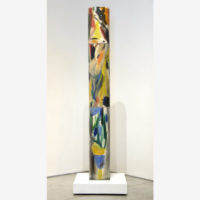ELAINE DE KOONING (1918-1989)
_27843.jpg)
_27843_detail1.jpg)
_27843_detail2.jpg)
_27843_detail3.jpg)
_27843_detail4.jpg)
_27843_detail5.jpg)
_27843_detail6.jpg)
_27843_detail7.jpg)
_27843_detail8.jpg)
_27843_detail9.jpg)
Provenienz
Familie von Elaine de KooningAusstellung
West Palm Beach, Florida, Ann Norton Sculpture Gardens, Entdeckung der Kreativität: Meister der amerikanischen Kunst, 10. Januar - 17. März 2024Preis375,000
Geschichte
Mary Gabriels brillante Erzählung über die Frauen, die ihren männlichen Kollegen erst hinterher und dann auf die Pelle rückten, musste irgendwann zu Ende sein. Immerhin ist "Ninth Street Women" 700 Seiten lang. Aber das letzte Kapitel mit dem treffenden Titel "Epilog" fasst die nächste Phase der New York School und des Abstrakten Expressionismus so zusammen, als sei sie 1960 gestorben, als Frank Stellas rigoros mit schwarzer Hausfarbe gemalte Leinwände die Kunstwelt in Aufruhr versetzten. In der Tat lag mehr als nur ein jahreszeitlicher Wechsel in der Luft von Manhattan, aber für drei Frauen - Joan Mitchell, Helen Frankenthaler und Elaine de Kooning - könnte nichts weiter von der Wahrheit entfernt sein. Viele ihrer besten Arbeiten sollten erst in den kommenden Jahrzehnten entstehen. Was Elaine anbelangt, so hatte sie 1957 einen hart umkämpften Kampf um ihre Selbstständigkeit gewonnen. Sie war frei von Willem, hatte ihr eigenes Auto, und wie um diese vollendete Tatsache zu unterstreichen, reiste sie in den Westen, erlebte die Farbe und Weite der Landschaft und kostete das Drama und die Farbe der Corrida auf der Plaza Monumental in Ciudad Juárez, Mexiko. Ihre Gemälde und Zeichnungen wurden von dem Dutzend Stierkämpfen inspiriert, an denen sie teilnahm. Sie sind Transmutationen dieser Erfahrung; wirbelnde Derwische aus Farben und herzklopfender Action. Die Inbrunst, mit der sie die Leinwand oder den Papierträger angriff, veränderte sich für immer. Plötzlich war hier eine Künstlerin, die dem Ideal von Harold Rosenberg gerecht wurde, als er die Geburt der "Aktionsmalerei... eine Arena, in der man handeln kann" nannte und feststellte, dass das, was auf der Leinwand erschien, "kein Bild, sondern ein Ereignis war."
MehrMARKTEINBLICKE
- Die beiden höchsten Preise für Elaine de Kooning-Gemälde, die auf einer Auktion verkauft wurden, wurden gerade im März 2021 erzielt, was den steigenden Wert der Werke von Elaine
- "Red Bison/Blue Horse" aus den 1980er Jahren stellte bei der Auktion am 9. März 2021 mit einem Preis von 562.500 USD einen neuen Rekord für den Künstler auf.
- Eine Woche später wurde ein Stierkampf-Gemälde von Elaine de Kooning aus den späten 1950er Jahren für 428.400 US-Dollar verkauft - der zweithöchste Auktionspreis für den Künstler.
- Wir sehen, dass Kunstwerke von historisch unterbewerteten Künstlern wie Elaine de Kooning weiter im Wert steigen.





























